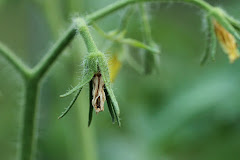On a garden tour this weekend I saw tomatoes 4 feet tall with fruit already set. The gardener said she got an early start and used water walls that were lifted off the plants a week ago. Quite a bit different than the June 1st planted plants I have that are 15 inches tall and just starting to flower. Temperature modification for an early start makes a big difference.
Speaking of temperature, both of our plants will be affected by tonight's low that is supposed to be in the forties Fahrenheit. It's always hard to believe that we could have temperatures this cool only a day following a 95 degree day that tied a record. Tomatoes will be stunted for a few days because the nighttime temperature is below the desirable nighttime low of 50 degrees F for tomatoes. This stunting increases the days needed to grow fruit to maturity. This is typical in high altitude areas in the summer and makes tomato growing difficult.
 On another subject, the effects of the hail discussed last time continue. The leaves of all types of plants are taking on a faded appearance from the hail nicks scarring the leaves. Plants look similar to when they are in need of water. Check soil carefully before resuming irrigation and if wet, don't water. Plants also may have yellowed lower leaves from roots that shut down due to the excessive rain that came with the hail. Adding more water too early will only compound the hail damage.
On another subject, the effects of the hail discussed last time continue. The leaves of all types of plants are taking on a faded appearance from the hail nicks scarring the leaves. Plants look similar to when they are in need of water. Check soil carefully before resuming irrigation and if wet, don't water. Plants also may have yellowed lower leaves from roots that shut down due to the excessive rain that came with the hail. Adding more water too early will only compound the hail damage. It can't be stressed enough to dig down and check soil moisture in the root zone before watering anytime but particularly following heavy rains.
Photo credit: Plant four days after hailstorm - Carl Wilson














 6. Fabric removed, Seed germination success!
6. Fabric removed, Seed germination success!








